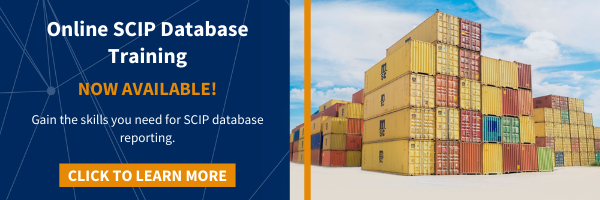Aerospace and defense Substances of Concern in Products (SCIP) reporting commences on January 5, 2021. With this comes the requirement of reporting Substances of Very High Concern (SVHCs) to the new European Union (EU) SCIP database.
While you may have been reporting SVHCs for years, aerospace and defense SCIP reporting presents unique challenges. To remain compliant across the EU, your company needs to understand the requirements for both the EU country you are working within — as well as your customers’ requirements. Your compliance team may also need additional training and skills in order to accurately report within the SCIP database.
These new requirements are significant. Careful planning can enable most companies to leverage existing templates, tools and processes to avoid a wholesale re-engineering of their compliance approach. Luckily, the aerospace and defense industries are well-versed in reporting SVHCs to the EU with REACH, and this past experience can help your team move forward into SCIP database reporting efficiently.
Groups like IPC and the International Aerospace Environmental Group (IAEG) have developed standard tools and processes so the aerospace supply chain is prepared to address new reporting requirements with existing data. In 2021, SCIP will put these tools to the test, as the aerospace and defense industry should have an inside track toward SCIP reporting with the data that has previously been collected.
Below are some best practices and lessons learned from REACH that your company can use to prepare for the upcoming changes.
Aerospace and Defense SCIP Reporting Shares Similarities With REACH Substances and Thresholds
Since 2015, SVHCs imported into the EU have been uniformly evaluated at the component level rather than the complex assembly level because of the EU’s “Once an Article, Always an Article” interpretation of REACH. Because of this approach to REACH reporting, the aerospace industry is well-positioned for SCIP threshold evaluation, which follows the same logic.
SCIP SVHC threshold evaluation takes place at the “Article-as-Such” level, which coincides precisely with the “Once an Article, Always an Article” level. Aerospace and defense companies who have been following the letter of the law on the REACH Article 33 Communication requirements will be able to transpose their findings to meet the new SCIP threshold evaluation requirements.
In fact, some EU member states are already indicating they may limit SCIP reporting requirements to cover only the same data already required under REACH Article 33. This means it is possible that some aerospace and defense companies already possess the data they need for SCIP. These companies then just need to translate that data into SCIP-compatible formats.
While this data transfer is not a trivial undertaking, companies that have already conducted their REACH SVHC reporting in databases that enable system-to-system reporting will be in the best position. Their REACH SVHC data can be automatically moved into SCIP once a few additional fields, such as TARIC codes, are added into the internal databases.
Using AD-SRT to Meet Aerospace and Defense SCIP Reporting Requirements
Developed by the IAEG, the Aerospace & Defense Substance Reporting Tool (AD-SRT) helps aerospace and defense companies collect, compile and evaluate hazardous substance information in aerospace components. It has been widely and successfully used in REACH SVHC reporting and is currently being updated to meet the new SCIP reporting requirements.
Table 1 below itemizes the required SCIP reporting fields and the corresponding candidate AD-SRT fields that can be used to satisfy those requirements. While not every entry may be legally required by every EEA member state, our conclusion is that it is very difficult to be fully SCIP compliant without capturing all of the below information.
TABLE 1 – Required SCIP fields for which the AD-SRT provides corresponding data fields
| SCIP DATA REQUIREMENT | CANDIDATE AD-SRT FIELD TO FULFILL REQUIREMENT |
| Article Name (Complex Object Level) | Product Group Description |
| Article Name (Article-as-Such Level) | Requester Product Group Description |
| Primary Article Identifier Value | Product Group ID |
| Number of Units | # of Instances |
| Candidate List Substance Name | Substance Identification —> Name |
| CAS Number | Substance Identification —> CAS |
| EC Number | Substance Identification —> EC |
| Concentration | Substance Mass —> Minimum
Substance Mass —> Maximum |
| Material Category | Material Use Description (indirectly inferred) |
| Requestor-Supplier tab Contact info on the Spreadsheet | Ability to link to LE User in ECHA Submission Portal (indirectly inferred) |
| Manufactured in EU? | Product Manufacturing Location (indirectly inferred) |
Note that not all information needed for SCIP is provided in the AD-SRT tool. For example, AD-SRT’s manufacturing location does not directly convey whether a product is made in the EU or not. To facilitate direct electronic system-to-system links between your databases and SCIP, you would need a precise indicator of whether the part is made in the EU or not.
One way to do this would be to re-program this to a “Yes/No” field rather than a free text field. Or perhaps your part numbers are coded by region, and you can electronically identify which parts are manufactured in the EU through the logic built into your part numbering approach. You can then program your system-to-system algorithm to associate certain part numbering schemes with “EU” or “non-EU.”
Also note that safe-use instructions are not captured in the AD-SRT. However, similar information can be found in relevant Safety Data Sheets that may be found in the Attachments tab of the AD-SRT.
As new candidate list substances emerge and engineering changes to your components occur, a change management process will be important for synchronizing your AD-SRT submission workflow with your SCIP reporting workflow. One action that might help in this process would be to capture the SCIP ID number in the AD-SRT. That way, when a change occurs, you will not have to re-enter a supplier part multiple times but can instead use the SCIP ID number to identify the existing record in your databases.

System-to-System Technology Upgrades to Meet Aerospace and Defense SCIP Requirements
For companies who currently use a third-party vendor to manage their AD-SRT submissions, there may soon be a system-to-system capability available to use, which will save them the manual data manipulation effort.
While each vendor is in a different stage of implementing its system-to-system capabilities, the IPC standards development website lists at least five vendors who support the IPC 1754 (Materials and Substances Declaration for Aerospace and Defense) standard:
Many other vendors can support aerospace SVHC reporting and may also be working on system-to-system data transfer capabilities.
Tetra Tech has experts for implementing data collection and data migration and can help you select a technology and/or optimize the use of your current third-party and/or internal SVHC database(s).
Now is the time to prepare your roadmap for transitioning your data and avoiding redundancies that could occur if you overlook the data you already have at your fingertips. Contact Tetra Tech today at [email protected] for support in SCIP reporting preparations and to learn more about the best practices emerging in the aerospace and defense industry on this new requirement.







